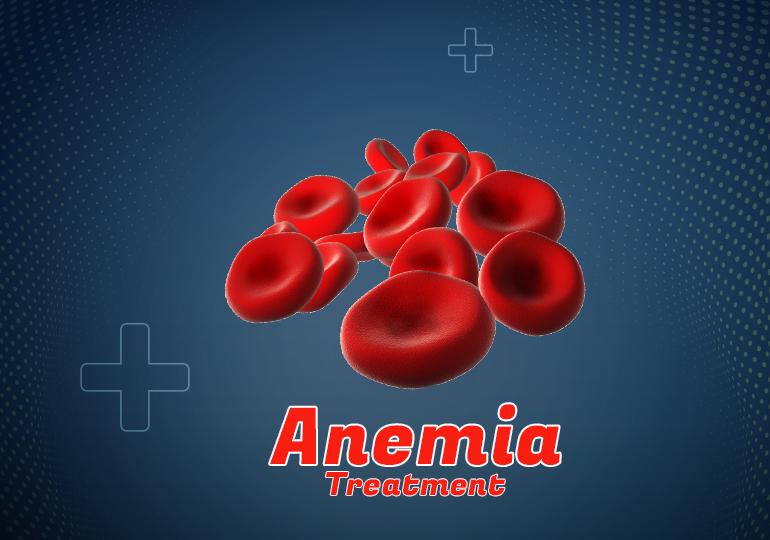Anemia treatment
It's a condition that occurs when you don’t have enough red blood cells, and it causes
symptoms such as lightheadedness, fatigue, weakness, and shortness of breath.
There are different types of anemia. They share similar symptoms but have different
causes as well as different treatments and severity levels. So let’s know more about
this medical condition.
____________________________________________________________
What Is Anemia?
Anemia is defined as a low number of red blood cells. In a routine blood test, anemia
is reported as a low hemoglobin or hematocrit. Hemoglobin is the main protein in your
red blood cells. It carries oxygen, and delivers it throughout your body. If you have
anemia, your hemoglobin level will be low too. If it is low enough, your tissues or
organs may not get enough oxygen. Symptoms of anemia happen because your
organs aren't getting what they need to work the way they should.
____________________________________________________________
What are the Symptoms?
The most common symptom of anemia is fatigue. Other common symptoms include:
- pallid complexion
- a fast or irregular heartbeat
- shortness of breath
- chest pain
- headache
- Dizziness, lightheadedness, or feeling like you are about to pass out
- Pain, including in your bones, chest, belly, and joints
- Problems with growth, for children and teens
- Cold hands and feet
However, symptoms vary from person to person. Some people with mild anemia may
experience few or no symptoms.
____________________________________________________________
Risk factor
Many people are at risk for anemia because of:
- Poor diet
- Intestinal disorders
- Chronic diseases
- Infections
- Women who are menstruating or pregnant
- People with chronic medical conditions
If you have any of the following chronic conditions, you might be at greater risk for
developing anemia:
- Rheumatoid arthritis or other autoimmune disease
- Kidney disease
- Cancer
- Liver disease
- Thyroid disease
- Inflammatory bowel disease (Crohn disease or ulcerative colitis)
____________________________________________________________
Anemia Types
There are many forms of anemia, and each type has telltale symptoms. Some
common types of anemia include:
- iron deficiency anemia
- vitamin B12 deficiency anemia
- aplastic anemia
- hemolytic anemia
- Iron deficiency anemia
____________________________________________________________
The most common Trusted Source form of anemia, iron deficiency anemia involves
the body producing too few RBCs due to a lack of iron in the body. It may develop as a
result of:
- a diet low in iron
- heavy menstruation
- frequent blood donation
- endurance training
- certain digestive conditions, such as Crohn’s disease
- medications that irritate the gut lining, such as ibuprofen
It can cause symptoms including:
- Fatigue
- lightheadedness
- cold extremities
____________________________________________________________
Vitamin B12 deficiency anemia
Vitamin B12 is essential for the production of RBCs. If a person does not consume or
absorb enough B12, their RBC count may be low.
Some symptoms include Trusted Source:
- difficulty walking
- confusion and forgetfulness
- vision problems
- Diarrhea
- glossitis, which is a smooth, red tongue
____________________________________________________________
Aplastic anemia
This rare blood condition happens when the bone marrow cannot produce enough new
RBCs. It is most often a result of an autoimmune disease that damages stem cells.
This occurs despite having normal iron levels.
It can cause symptoms such as Trusted Source:
- Fatigue
- frequent infections
- skin rashes
- bruising easily
____________________________________________________________
Hemolytic anemia
This type of anemia happens when RBCs are destroyed faster than the body can
produce new ones. A variety of conditions can cause this, such as autoimmune
diseases, infections, bone marrow problems, and inherited conditions such as sickle
cell disease and thalassemia.
Hemolytic anemia can cause symptoms including Trusted Source:
- dizziness
- weakness
- jaundice
- dark urine
- Fever
- abdominal pain
____________________________________________________________
How do healthcare providers treat anemia?
First, your healthcare provider will determine if you have anemia caused by a poor diet
or a more serious health problem. They may refer you to a hematologist, a healthcare
provider who specializes in blood disorders. Here are some examples of common
anemia treatments:
Healthcare providers may recommend changing your diet or taking supplements if you
have iron-deficiency anemia or pernicious anemia.
If you have anemia because you have a chronic disease, your provider will treat the
underlying condition. They may prescribe medication to boost red blood cell
production.
Providers may use medications like immunosuppressants or treatments like blood
transfusions to treat anemias that happen when you have abnormal red blood cells,
like aplastic anemia or hemolytic anemia.
____________________________________________________________
PREVENTION
Can I prevent developing anemia?
You can’t prevent some kinds of anemia, such as sickle cell anemia, hemolytic
anemia or aplastic anemia. People with chronic diseases who may develop anemia
should watch for anemia symptoms. And you can prevent nutritional anemias by
eating a healthy diet.
____________________________________________________________
- [email protected]
- Airport Road, In front of Rajack School
For Support Call
+20 12 02 66 7788
 العربية
العربية

